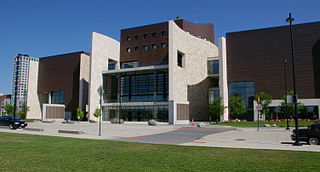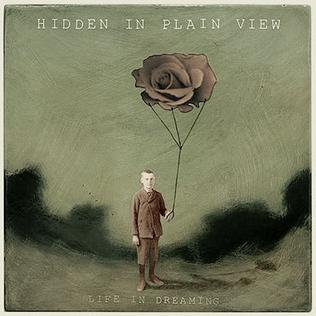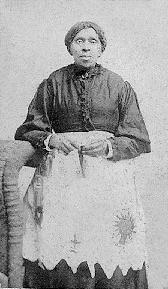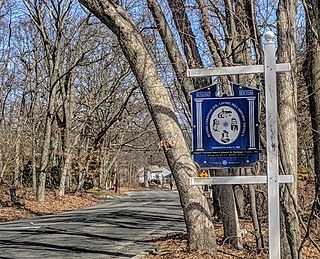
Quilting is the process of sewing two or more layers of fabric together to make a thicker padded material, usually to create a quilt or quilted garment. Typically, quilting is done with three layers: the top fabric or quilt top, batting or insulating material and backing material, but many different styles are adopted.

The Underground Railroad was a network of secret routes and safe houses established in the United States during the early to mid-19th century, and used by African-American slaves to escape into free states, Canada and Nova Scotia with the aid of abolitionists and allies who were sympathetic to their cause. The term is also applied to the abolitionists, both black and white, free and enslaved, who aided the fugitives. Various other routes led to Mexico or overseas. An earlier escape route running south toward Florida, then a Spanish possession, existed from the late 17th century until Florida became a United States territory in 1821. However, the network now generally known as the Underground Railroad was formed in the late 1700s, and it ran north to the free states and Canada, and reached its height between 1850 and 1860. One estimate suggests that by 1850, 100,000 slaves had escaped via the "Railroad".

The National Underground Railroad Freedom Center is a museum in downtown Cincinnati, Ohio based on the history of the Underground Railroad. Opened in 2004, the Center also pays tribute to all efforts to "abolish human enslavement and secure freedom for all people."

Drive-Thru Records, established in 1996, was a California-based independent record label owned by siblings Richard and Stefanie Reines. The label was partially responsible for popularizing the pop-punk/emo sound of the early to mid-2000s. After facing financial obstacles in getting their bands' music into stores, Drive-Thru entered into a distribution deal with MCA/Universal. MCA was dissolved and changed into Geffen Records. One of the clauses of that agreement was MCA/Geffen being able to sign any band of their choosing from Drive-Thru's roster.

Life in Dreaming is Hidden in Plain View's first full-length album, released on February 22, 2005 by Drive-Thru Records. It was originally scheduled for an August 2004 release, but was postponed until February 2005 to gain time for promotion. The album includes an Enhanced CD portion with video footage of a live performance of "Twenty Below" at Chain Reaction in Anaheim, California and a making-of featurette.

Operation: Cut-Throat is Hidden in Plain View's second EP. It was originally released on Note to Self Records in 2002 and re-issued by LLR Recordings in 2003.

Thomas Garrett was an American abolitionist and leader in the Underground Railroad movement before the American Civil War.

In geometry, the rhombille tiling, also known as tumbling blocks, reversible cubes, or the dice lattice, is a tessellation of identical 60° rhombi on the Euclidean plane. Each rhombus has two 60° and two 120° angles; rhombi with this shape are sometimes also called diamonds. Sets of three rhombi meet at their 120° angles and sets of six rhombi meet at their 60° angles.
Robert Andrew Freeman is currently the guitarist, backing vocalist and primary songwriter for the pop punk/post-hardcore group Hidden in Plain View. Presently, he owns/works at The Pilot Studio as a record producer, recording various up and coming artists.

"Wade in the Water" is the name of a Negro spiritual first published in New Jubilee Songs as Sung by the Fisk Jubilee Singers (1901) by John Wesley Work II and his brother, Frederick J. Work. It is associated with the songs of the Underground Railroad.

Harriet Powers was an African-American slave, folk artist, and quilt maker from rural Georgia. She used traditional appliqué techniques to record local legends, Bible stories, and astronomical events on her quilts. Only two of her quilts are known to have survived: Bible Quilt 1886 and Pictorial Quilt 1898. Her quilts are considered among the finest examples of nineteenth-century Southern quilting. Her work is on display at the National Museum of American History in Washington, DC, and the Museum of Fine Arts in Boston, Massachusetts.

Judge William Shaw Anderson House is a building in Austintown, Ohio, listed in the National Register of Historic Places on 1976-03-17. It is also known as the "Strock Stone House."
Find or FIND or Finding may refer to:

In the textile arts, a motif (pronunciation) (help·info) is a smaller element in a much larger work. In knitting and crochet, motifs are made one at a time and joined together to create larger works such as afghan blankets or shawls. An example of a motif is the granny square. Motifs may be varied or rotated for contrast and variety, or to create new shapes, as with quilt blocks in quilts and quilting. Contrast with motif-less crazy quilting.
Jane Burch Cochran is a fabric artist who is known for her work that combines traditional American quiltmaking with painting and fabric embellishments. She received a National Endowment for the Arts fellowship for quiltmaking in 1993.

Animal is Hidden in Plain View's first release since they regrouped in 2014. This marks the bands 6th release. This was also their first release on Rise Records. This was released on April 14, 2015.
Cecelia Tapplette Pedescleaux, also known as Cely, is an African-American quilter of traditional and art quilts, inspired by historians, other African-American quilters, and quilt designs used during the Underground Railroad to communicate messages to slaves seeking freedom. Her quilts have been shown in China, France, Washington, D.C., New Orleans, and in other locations in the United States. A solo show of 75 of her quilts were shown at the Le Musée de Free People of Color in New Orleans (2013–2014).

Bethel-Christian Avenue-Laurel Hill Historical District is a Setauket, Long Island, New York neighborhood that was nominated for preservation as an endangered historic site in 2017.














